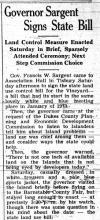The Martha’s Vineyard Commission voted unanimously last week to accept a set of regulations for a new district of critical planning concern (DCPC) aimed at protecting the historic and environmental integrity of the Vineyard Haven harbor.
The special planning district is the first of its kind for a town harbor.
If the regulations are approved by voters at a special town meeting in October, they will become part of the town zoning bylaws. The regulations saw enthusiastic support from the public at a hearing last week.
“This is exactly what is needed for the working waterfront and to prevent overdevelopment of the harbor,” said Margaret Wolontis, a Tisbury resident.
The comment came during a public hearing last Thursday night at the MVC office in Oak Bluffs.
Philip P. Hale, president of the Martha’s Vineyard Shipyard, also voiced his support for the detailed regulations and praised the year-long community effort that went into developing the special planning district.
“We started this process in the early winter,” said Tisbury selectman Tristan Israel. “It’s been an almost excruciatingly public process.”
While most traditional uses of the harbor will be unaffected, under the new regulations some activities will require special harbor-use permits. Permits will be required for commercial uses such as water taxi and commercial launch service, oceanographic research, new freight and ferry services, seaplane and floatplane services and dredging.
People who own piers in the district will not be allowed to use them for commercial purposes without a harbor-use permit.
The current regulations also focus on the waterfront land areas along the harbor, and there are provisions to protect the rights of pedestrian access.
At the hearing last week, this section of the bylaw was the subject of some discussion, and some members of the commission questioned the legality of the pedestrian access rules.
Commission member Michael Colaneri said the section ignored the rights of beachfront property owners. “You can’t give people who don’t have the right, the right to do these things. Any bylaw can’t give people rights they don’t have,” he said. “It’s a very big deal,” he added.
Tisbury selectman Tom Pachico disagreed. “This section is telling you what you may do with your land on the waterfront. The pedestrian part is incidental,” he said.
“It’s telling people that they can use their land for certain things as long as they are not impeding the flow of pedestrians walking down the beach,” he added.
There were some minor language changes.
Commission member Leonard Jason Jr. reminded the group that the role of the commission at this stage was only to make sure that the regulations comply with the guidelines, developed much earlier in the planning process.
“All we want to do is see if they comply with the guidelines, and they clearly do,” Mr. Jason said.
In the end the commission voted to accept the new regulations.
A special town meeting is now set for Oct. 24 for the last step in creating the new harbor DCPC: voter approval. If voters adopt the regulations, a yearlong moratorium which has been in effect on all new activities in the harbor will end.
The regulations are available for public inspection at the commission office in Oak Bluffs and also in the Tisbury town hall.







Comments